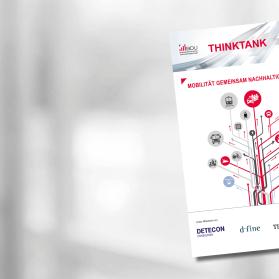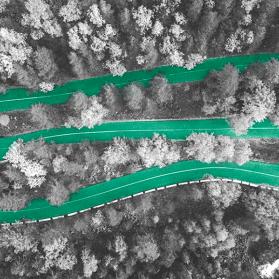This is the second part of our mini-series of articles on the topic of data sharing in the age of mobility as a service (MaaS). Our remarks are based on discussions we have had with various experts from the moility sector.
In the first part of our article series, we presented important use cases in a MaaS ecosystem that require intensive data sharing. But how is this sharing to be implemented for practical use in real life? The implementation can take many different forms. We can describe this best in terms of two fundamental questions:
- Degree of openness: How open or restrictive should I make the access to data?
- Realization: What technical solutions are used to pool and share data?
The question about the degree of openness of the data sharing sparks especially heated discussions. Open data1 have been the talk of the town for some time. Essentially, this is a tried and proven concept that has been applied in isolated situations in various domains for decades – for flight schedules and timetables, for instance, or in research. As is the case in so many industries, however, efforts are underway in the mobility sector as well to open access to even more data.2 Various players in the MaaS ecosystem nevertheless continue to treat much of their data inventory as proprietary, in no small part out of concern about the competition. In other words: the players closely guard the data for their own use. One possible compromise is offered by shared data frameworks. The basic principle here is that data are shared, yes, but only within an authorized group of users. Contractual and technical constraints regulate who has access to what data and subject to what restrictions.
What data sharing approach is most suitable for what mobility data? This is completely dependent on the purpose and who you ask. The objectives pursued by the MaaS ecosystem players differ from one player to the other, in some cases drastically – from companies operating in the private sector who would like to strengthen their competitive position to public services searching for solutions to exploding needs for mobility. What has become clear, however, is that without more consensus and concrete initiatives to open the access to data relevant for the system, the development of many aspects of an integrated MaaS ecosystem will be sluggish. In the remarks below, we will discuss several key issues pointing to the future of data sharing that the industry is currently examining intensively.
Issue 1: shared v. open (1/3) – How do you maximize data availability and quality in the ecosystem?
“Data are valuable; why should I share them?” – service provider
Mobility service providers must offer an attractive customer experience to their customers. This is equally true for an established carrier and a travel planner startup. Yet they are all dependent on up to date, reliable, and adequately complete data within the ecosystem if they are to achieve this objective. In the MaaS context, these requirements are especially demanding; as it is a real-time system, the half-life of data is extremely short. A lot of the data must be updated daily, hourly, or, in some cases, every second. Examples include the localization of vehicles, availability of parking spaces, or disruptions in rail traffic.
What is more suitable for ensuring this data availability and quality – an open or a shared data framework? There are numerous success stories revolving around open data projects; one example of many we can mention is the “OpenStreetMap”. Simple access to a great diversity of redundant data records could make it possible to create a highly accurate image of (mobility) reality – in theory, at least. But this is only possible if the ecosystem players can be persuaded to share their data reliably for this purpose.
Various mobility companies see their proprietary data as critical for their survival in the competition. The automotive industry serves as a good example of this. The rising popularity of carsharing and autonomous driving is viewed with trepidation as a potential degradation of the car from a luxury object to a simple commodity. Why should anyone share data that accelerate this development and potentially lay the foundation for future business models? An open data framework in a MaaS ecosystem may possibly lead to a freeloader syndrome: I take the data that I can get, but do not share my own.
It is possible to put a stop to this through government intervention. In Switzerland, for instance, there are already initiatives to compel public transportation companies to disclose their data that are relevant for the system, much to the disadvantage of the impacted companies, who regard this to be a one-sided distortion of competition. Might it be possible to force similar disclosures in the private sector? Moreover, companies have for all practical purposes innumerable opportunities to make their data public while simultaneously making them completely useless for steering a productive transportation system. Examples are delays in making data records public or making them available in unstructured form or formats that are not machine-readable without significant effort. Such actions are not necessarily a consequence of business tactics. Processing and making data available in good time simply cost time and money. If the disclosure does not come from deeply held convictions, there is little incentive to make more than a minimum effort. In addition to the clear identification of all data relevant for the system, there is a further necessity for government authorities to establish clear general conditions for frequency and form of the disclosures.3 At the moment, such efforts are still in their infancy.
The basic challenge of motivating companies to disclose their data exists with respect to shared data frameworks as well. An obvious advantage of the latter is that exclusive access to mobility data can serve as a direct incentive to share one’s own data. This can prove to be effective above all if and when large mobility service providers who are sitting on valuable stores of data set a good example and make their data available in an ecosystem of this type.
Issue 2: shared v. open (2/3) – Who should have control over the development of mobility?
“The development of mobility is too important to leave it up to the private sector” – various respondents in the study
Whoever has control of the routing algorithms in a MaaS ecosystem has power. This effect becomes all the more striking as diversity of possible transportation means in the mobility system rises – and with it, the number of intermodal opportunities for the satisfaction of a specific travel need. Various players in the ecosystem are interested in assuming the role of the mobility integrator. The motivation to do so comes from considerations that are almost diametrically opposed. Mobility service providers would like to retain their direct contact to customers and not be “degraded” to simple carriers. The state, communities, and municipalities are interested in the regional optimization of mobility flows. Private sector platform operators see data brokerage and routing services as intrinsic business models. Conflicts of interest are inevitable. Is it permissible for a company to be a mobility integrator and, at the same time, a carrier? Who should steer the mobility flows in Berlin – Google or the city?
If sufficient quantities of mobility data are made freely accessible, practically any motivated player can try its hand at being a mobility integrator. Potentially, this would relinquish a major part of the control over the development of mobility to the private sector. A number of the interviewed experts, especially those from fields close to the public sector, are skeptical about such a step. There is no agreement, however. Some of the other experts see this as a chance for the development of efficient routing systems and therefore the next logical step for a flourishing MaaS ecosystem. If the aim is to retain more control over the development in the hands of the public sector, however, a closed data ecosystem would be one possible way to achieve this.
Issue 3: shared v. open (3/3) – Can innovation be encouraged as strongly with shared data as with open data?
The future of mobility is still in the stars. An effective MaaS ecosystem must be capable of evolving as the needs for mobility change. One frequently mentioned requirement for the underlying data ecosystem is therefore the simplest possible access to mobility data for third parties so that crowd sourcing is encouraged.
Crowd sourcing and open data go hand in hand. Free access to data is the starting point that enables startups, inventors, mavericks, academic institutes, and established companies to take part in the ecosystem. Can such an innovation effect be replicated if mobility data are in part hidden away in a closed data ecosystem? If not, it is a valid argument against shared data frameworks. A basic point: even in these frameworks, data can be made accessible to third parties. It is just more complicated. The decisive points determining the suitability of crowd sourcing in this case are the concrete technical, procedural, and contractual conditions for data access. What data would be public, for what data would access be restricted? Who manages the access? How complicated would the authorization procedures for accessing the closed part of the system be? What are the approval criteria?
The weight of such questions must be qualified to a certain degree. As of now, crowd sourcing solutions in the mobility sector have barely advanced beyond the stage of interesting experiments. But this may be a consequence of the fact that insufficient data of adequate quality are accessible.
Issue 4: How do we integrate transactional data from various mobility services?
“In the event of occurrence of damage, frequently all the operators of a mobility chain must know the traveler” – mobility service provider
There are obvious reasons why the sharing of data relevant for transactions such as performance, customer, and payment information must be handled restrictively. Nevertheless, there is plenty of room to maneuver within these constraints. At one end of the spectrum we see completely independent sales systems with open interfaces that are combined into door-to-door services by mobility integrators. The data sharing itself is reduced to a minimum; persistent data about sold services exist only in isolated sales systems. The mobility integrator is the party faced with the challenge of presenting one face to the customer and simultaneously “speaking” with the various systems in the background.4
At the other extreme is an industry-wide, closed sales back end that hosts all customer data and mobility services. This would be similar to concepts such as that of the “Industrial Data Space Association,” for example. Depending on the use case, docked sales systems can retrieve the data required for the specific situation or supplement the data for the processing of sale, refund, and billing of mobility services.
Many different compromise solutions can be imagined between these two extremes.5 One important factor in weighing the pros and cons of the approaches must be the robustness of the ecosystem when dealing with “corner cases” – this is the general feeling of our interviewees. This includes, for instance, the handling of aftersales activities such as refunds or the sharing of data when accidents have occurred. The scope of customer information that the various mobility service providers along the travel chain must possess in such cases is considered to be significantly greater than in the trouble-free “vanilla” case.
Issue 5: What procedures are used for the anonymization and aggregation of data records?
This issue is of fundamental significance for the use of movement data histories. The possible attribution of the data records to specific individuals, by whatever circuitous means, must be precluded. One classic case is that of a pseudo-anonymization of personal data, a procedure by which the identity of the traveler is simply replaced by a synthetic ID; it is not unusual to be able to determine the mobility behavior of a specific person under these circumstances. One way to do this is to compare the information with other data points such as the use data of location-based apps. This risk exists even for data aggregation – in rural areas, for instance, where the mobility density is lower. The aggregation and anonymization process is therefore anything but trivial. Finding a consensus about this that is accepted legally, publicly, and across the entire industry represents a challenge demanding intensive efforts of education and coordination.6
Mobility platforms as signposts pointing the way to mobility of the future
As the passages above reveal, common platforms for the sharing of mobility data were a recurring topic in our interviews. Potentially, they can be a major catalyst for data sharing in the sector. At the same time, however, design and implementation are highly demanding. The conceptualization of such platforms must incorporate as anchoring points major decisions regarding fundamental principles of the technical and compatible architecture of the ecosystem as well as the future division of roles among the actors in the mobility environment. The issues discussed above illustrate partial aspects of this challenge. They may the reason why data sharing in mobility – despite various platform initiatives7 – continues to develop at a sluggish pace.8 But the dialog and the efforts concentrating on platforms will continue. Ultimately, they will have to prove in reality which of them have a right to exist.
It will be especially exciting to see what the characteristics of successful mobility platforms will look like in the following four dimensions:
- Ownership: Who will the platforms belong to? The state, a neutral interest group, a conglomerate of mobility companies, or third-party providers from the private sector?
- Motivation: What objectives will players pursue with them? The development of mobility for the common good, the strengthening of the economic position of mobility companies, or data brokerage as a service?
- Use cases: For what use cases will they be used? Routing, sales, data analytics, or others?
- Data sharing framework: How will data sharing be designed for what types of data? Open or shared, structured or unstructured?
Many of the answers will permit interesting conclusions about the shifts in power relationships in the mobility sector to be drawn. They will also cast a light on the industry’s ability to find a common denominator for competition, cooperation, and social interests. Things will remain interesting for some time. Stay up to speed with us.
1Data in an easily usable form are shared, without restrictions and without being tied to specific purposes, with the general public for the use, dissemination, and aggregation with other data sets (see, for example, http://opendatahandbook.org/guide/en/what-is-open-data/).
2In Switzerland, for example, there is currently an initiative at the national level seeking the opening of data relevant for transportation for public transportation (https://www.admin.ch/gov/de/start/dokumentation/medienmitteilungen.msg-id-73269.html).
3Important margin note: We are assuming that data, whether as open data or in shared data frameworks, can be made available in either structured or unstructured form.
4There are pilot projects in progress to determine how the integration of this sales back end might function, e.g., via an intermediate layer based on blockchain or a “metaplatform”.
5Public transportation companies – e.g., in Switzerland – are already today operating a common sales platform whose interface is now to be opened to third parties.
6https://theodi.org/article/why-businesses-arent-sharing-more-data/
7Besides the previously mentioned “Industrial Data Space Association”, the Swiss mobility platform “ITS-CH”, the “Data Market Austria Project”, and the European “MaaS Alliance” are examples.
8“Data Sharing – wie Schweizer Unternehmen ihre Daten gemeinsam besser nutzen können” – short report on the SATW Forum of 26/11/2018
Click here to download the German-language discussion paper Smart Mobility - Data and Data Sharing as Enablers for Smart Ecosystems









